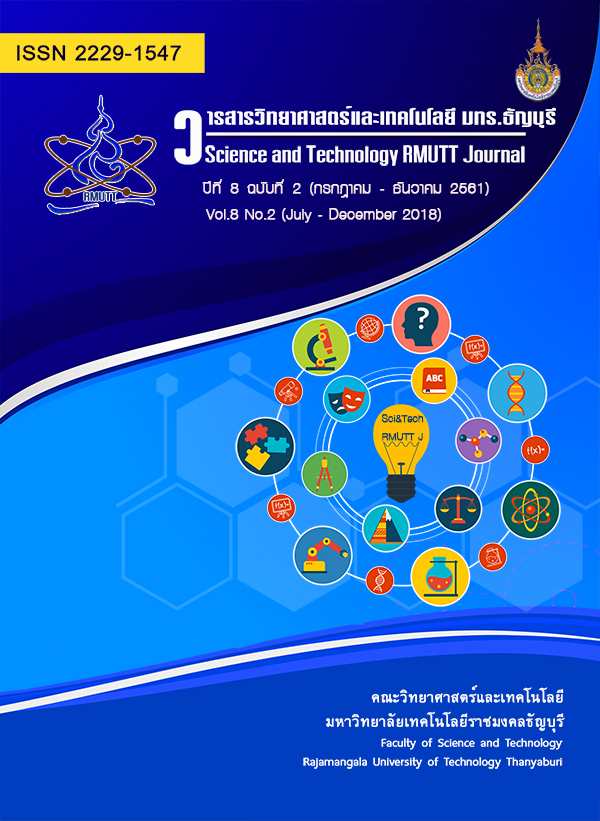In situ anti-Staphylococcus aureus activities of ethanolic leaf extract of Rhodomyrtus tomentosa (Aiton) Hassk. in raw chilled pork
Main Article Content
Abstract
Ethanolic extract of Rhodomyrtus tomentosa leaf contained antibacterial activities against many Gram-positive pathogenic bacteria, including Staphylococcus aureus. This study investigated antibacterial effects on S. aureus using both n vitro and in situ assays. In vitro studies were determined by Time kill, Biofilm formation and colonial morphology detection. In situ assay was analyzed an anti-bacterial activity of the extract against S. aureus in chilled pork. Time-kill assay shown that the extract at a concentration of 4MIC (1.24 mg/ml) could reduce the number of S. aureus cells by 99.9% within 24 h. The ethanolic extract at more than or equal MIC concentration could prevent biofilm formation and inhibited slime and Staphyloxanthin production. In addition, the extract inhibited S. aureus growth in raw pork during storage at 10 ºC compared to control and 10% salt solution in 3 days of storage. The results of this study revealed that the extract of R. tomentosa could be an alternative preservative chemical compound to inhibit bacteria and may be employed in food preservation and pharmaceutical purposes.
Article Details
References
Oniciuc E.A., Nicolau A.I., Hernández M., and Rodríguez-Lázaro D. (2017). Presence of methicillin-resistant Staphylococcus aureus in the food chain. Trends in Food Science & Technology, 61, 49-59.
Huang Y.C., Chen C.J., Kuo C.C., and Lu M.C. (2018). Emergence, transmission and phylogeny of meticillin-resistant Staphylococcus aureus sequence type 8 (USA300) in Taiwan. Journal of Hospital Infection, 100(3), 355-358.
Hawken P., Weese J.S., Friendship R., and Warriner K. (2013). Carriage and dissemination of Clostridium difficile and methicillin resistant Staphylococcus aureus in pork processing. Food Control, 31(2), 433-437.
Argudín, M.Á., Mendoza, M.C., & Rodicio, M.R. (2010). Food poisoning and Staphylococcus aureus enterotoxins. Toxins, 2(7), 1751-1773.
Mulcahy M.E., and McLoughlin R.M. (2016). Host–bacterial crosstalk determines Staphylococcus aureus nasal colonization. Trends in Microbiology, 24(11), 872-886.
Dehghan P., Mohammadi A., Mohammadzadeh-Aghdash H., and Dolatabadi J.E.N. (2018). Pharmacokinetic and toxicological aspects of potassium sorbate food additive and its constituents. Trends in Food Science & Technology, 80, 123-130.
Hugo C.J., and Hugo A. (2015). Current trends in natural preservatives for fresh sausage products. Trends in Food Science & Technology, 45(1), 12-23.
Pobiega, K., Kraśniewska, K., & Gniewosz, M. (2018). Application of propolis in antimicrobial and antioxidative protection of food quality–A review. Trends in Food Science & Technology, 83, 53-62.
Gutiérrez-del-Río, I., Fernández, J., & Lombó, F. (2018). Plant nutraceuticals as antimicrobial agents in food preservation: terpenoids, polyphenols and thiols. International Journal of Antimicrobial Agents, 52(3), 309-315.
Visutthi M. (2016). Anti-Staphylococcal screening of selected Thai medicinal plants from Nakhon Ratchasima province. Suranaree Journal of Science and Technology, 23(2), 109-114.
Odedina G. F., Vongkamjan K., and Voravuthikunchai S. P. (2015). Potential bio-control agent from Rhodomyrtus tomentosa against Listeria monocytogenes. Nutrients, 7(9), 7451-7468.
Srisuwan S., Mackin K. E., Hocking D., Lyras D., Bennett-Wood V., Voravuthikunchai S. P., and Robins-Browne R. M. (2018). Antibacterial activity of rhodomyrtone on Clostridium difficile vegetative cells and spores in vitro. International Journal of Antimicrobial Agents. 52(5), 724-729.
Limsuwan S., Kayser O., and Voravuthikunchai S. P. (2012). Antibacterial activity of Rhodomyrtus tomentosa (Aiton) Hassk. leaf extract against clinical isolates of Streptococcus pyogenes. Evidence-Based Complementary and Alternative Medicine, 2012, Article ID 697183, 6 pages.
Saising J., and Voravuthikunchai S. P. (2012). Anti Propionibacterium acnes activity of rhodomyrtone, an effective compound from Rhodomyrtus tomentosa (Aiton) Hassk. leaves. Anaerobe, 18(4), 400-404.
Saising J., Ongsakul M., and Voravuthikunchai S. P. (2011). Rhodomyrtus tomentosa (Aiton) Hassk. ethanol extract and rhodomyrtone: a potential strategy for the treatment of biofilm-forming staphylococci. Journal of Medical Microbiology, 60(12), 1793-1800.
Merritt J. H., Kadouri D. E., and O'Toole G. A. (2011). Growing and analyzing static biofilms. Current Protocols in Microbiology, 22(1), 1B-1.
Freeman D. J., Falkiner F. R., and Keane C. T. (1989). New method for detecting slime production by coagulase negative staphylococci. Journal of Clinical Pathology, 42(8), 872-874.
China R., Mukherjee S., Sen S., Bose S., Datta S., Koley H., Ghosh S., and Dhar P. (2012). Antimicrobial activity of Sesbania grandiflora flower polyphenol extracts on some pathogenic bacteria and growth stimulatory effect on the probiotic organism Lactobacillus acidophilus. Microbiological Research, 167(8), 500-506.
Flamm R.K., Farrell D.J., Rhomberg P.R., Scangarella-Oman N.E., and Sader H.S. 2017. Gepotidacin (GSK2140944) in vitro activity against Gram-positive and Gram-negative bacteria. Antimicrobial Agents and Chemotherapy, 61: e00468-17.
Sweeney D., Shinabarger D.L., Arhin F.F., Belley A., Moeck G., and Pillar C.M. (2017). Comparative in vitro activity of oritavancin and other agents against methicillin-susceptible and methicillin-resistant Staphylococcus aureus. Diagnostic Microbiology and Infectious Disease, 87(2), 121-128.
Götz F. (2002). Staphylococcus and biofilms. Molecular Microbiology, 43(6), 1367-1378.
Resch A., Rosenstein R., Nerz C., and Götz F. (2005). Differential gene expression profiling of Staphylococcus aureus cultivated under biofilm and planktonic conditions. Applied and Environmental Microbiology, 71(5), 2663-2676.
Leejae S., Hasap L., and Voravuthikunchai S. P. (2013). Inhibition of staphyloxanthin biosynthesis in Staphylococcus aureus by rhodomyrtone, a novel antibiotic candidate. Journal of Medical Microbiology, 62(3), 421-428.
Hmoteh J., Musthafa K. S., and Voravuthikunchai S. P. (2018). Effects of Rhodomyrtus tomentosa extract on virulence factors of Candida albicans and human neutrophil function. Archives of Oral Biology, 87, 35-42.
Srisuwan S., and Voravuthikunchai S. P. (2017). Rhodomyrtus tomentosa leaf extract inhibits methicillin-resistant Staphylococcus aureus adhesion, invasion, and intracellular survival in human HaCaT keratinocytes. Microbial Drug Resistance, 23(8), 1002-1012.
Na-Phatthalung P., Teles M., Voravuthikunchai S. P., Tort L., and Fierro-Castro C. (2018). Immune-related gene expression and physiological responses in rainbow trout (Oncorhynchus mykiss) after intraperitoneal administration of Rhodomyrtus tomentosa leaf extract: A potent phytoimmunostimulant. Fish & Shellfish Immunology, 77, 429-437.


